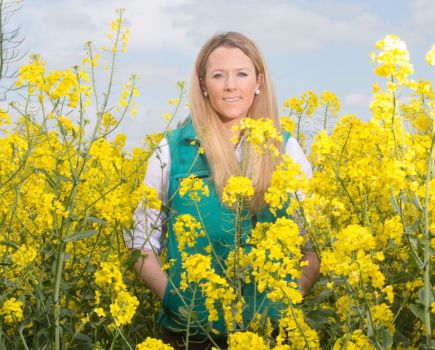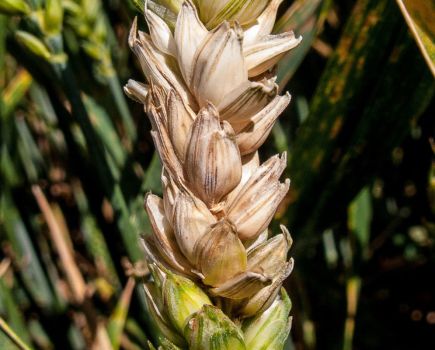As growers grapple for climate-smart solutions to improve efficiencies and meet the ever-growing net zero targets, could the unlocked potential in volcanic rock be the answer? CPM finds out more.
“What’s uplifting about this idea is that it offers hope for the efficacy of geo-engineering more generally.” – PROFESSOR DAVID BEERLING
By Charlotte Cunningham
In the rolling fields of British agriculture, a quiet revolution is taking place – one that could fundamentally transform how the industry approaches soil health, crop productivity, and climate change mitigation. According to the experts, this future of farming may well be written in stone – volcanic stone, to be precise…
This is because at the heart of this agricultural alchemy lies an unexpected hero: crushed basalt, a volcanic rock with the potential to rewrite the narrative of sustainable farming.
A recent webinar hosted by the Royal Agricultural Society of England (RASE) explored this topic in more detail, giving an in-depth insight into advanced rock weathering and why crushed basalt could be a sustainable source for soil acidity, crop yields and climate.
While the concept of enhanced rock weathering might sound like complex scientific jargon, its fundamental principle is simple, explained Arran Redmond, soil scientist and soil natural resources advisor at Innovation for Agriculture. “Rock weathering is a natural process where minerals break down over time due to exposure to rain and biological activity. When silica and carbonate rocks, like basalt, interact with CO2, they undergo a chemical reaction which transforms CO2 into bicarbonates and carbonates.”
Looking at this in more detail, and relaying this in practical terms, the process of enhanced weathering involves applying crushed volcanic rock, primarily basalt, to agricultural land. As the rock breaks down, it captures carbon dioxide from the atmosphere, converts it into bicarbonates, and ultimately sequesters carbon while simultaneously improving soil conditions.
Arran said this phenomenon has been picked up by both agricultural and wider industries globally and could offer a way of helping UK farmers mitigate against climate change and meet national carbon budgets.
Leading this agricultural innovation are researchers including Professor David Beerling, founder of the Leverhulme Centre for Climate Change Mitigation at the University of Sheffield. The mission of this centre has been a focus on trying to understand the potential for enhanced weathering to be a climate change mitigation option that works with agriculture, he explained.
IN-FIELD TRIALS
“Our centre is split across four different areas where we do large[1]scale field trials, trying to understand the performance of this sort of technology in the field. This is as well as earth systems modelling, where we simulate the breakdown of the minerals in soils all the way from individual grains to the entire globe.
“We also do social science work, where we engage in local communities and different publics in different countries, trying to understand its acceptability. The fourth area is focused on sustainability, looking at what the potential for increasing resource provision to deliver this through changing our supply chains is.”
David said that utilising carbon dioxide removal technologies – like enhanced weathering – is going to be vital to meet both net zero targets and the terms of the Paris Agreement which the UK is committed to. “The challenge is that we don’t fully understand whether it’ll work or not yet, so we urgently require long-term in-depth research programmes to figure everything out, but there’s certainly opportunity.”
While more work may be required, David has been leading a lot of the research into these systems as part of a 10-year £10M project at the Leverhulme Centre. Reflecting on what’s been established so far, he said: “There are three main things to consider with enhanced weathering. The first one is it uses natural reactions between volcanic rocks and plants, and these are the reactions that have been stabilising climate over geological timescales. They’re natural reactions. It’s not like direct air capture, for example.
“We also think it could be deployable at scale within a decade or two,” he continued. “This is because humanity has known for a long time how to do quarrying, and has long applied rocks to the landscape, particularly limestone, for pH management. The third thing is that you can co-deploy it with other proposed land-based carbon dioxide removal strategies. So for example, if you were doing reforestation schemes, you could combine basalt with tree planting.
“While it may sound like jargon to say it’s stackable with other CO2 technologies, there are some real benefits. As well as the carbon dioxide removal, there’s great potential to improve food security by increasing yields and improving soil health. It’s a win-win. What’s uplifting about this idea is that it offers hope for the efficacy of geo-engineering more generally.”
Delving into the benefits to soils and crops, at the core of enhanced weathering’s potential is its profound impact on soil chemistry. Traditional agricultural practices have long struggled with soil acidification, primarily caused by repeated nitrogen fertiliser applications. However, basalt application offers a nuanced solution to reverse this, gradually raising soil pH and creating an optimal growing environment, explained David.
It can also reverse the silica stripping of soils, he added. “Many of our food crops are silica-depleted by growing them repeatedly on the same soils and taking the biomass off-site. This leads to the slow stripping of biologically available silica from those soils. By putting a silicate rock on, you’re replenishing those pools.”
Relatedly, by taking biomass off-site, it also strips those soils of essential micronutrients like molybdenum, phosphorus and potassium, noted David. “Again, as the basalt weathers, it can release these nutrients and replenish those stocks; it’s about creating a more holistic nutritional environment. These trace elements support plant metabolism, potentially improving crop resistance to environmental stresses.”
CATION EXCHANGE
The final key benefit is the improvement to overall soil health by boosting cation exchange, for example, nutrient holding capacity. “This can stimulate root growth and that in turn produces greater inputs of organic carbon.”
In field-scale trials set up in the US Corn Belt to explore how this concept works in different climates and cropping, David said the results have shown some compelling results – particularly for carbon sequestration.
“In the Corn Belt, the typical rotation is maize, maize, soyabean, with two reasons for that. One is cultivating maize requires a lot of nitrogen fertiliser, so after the second year of doing that, growing a nitrogen-fixer like soyabean gives the soil a chance to recover. But also, there’s a problematic root pest in maize, and by having the third cycle of soyabean it gives time to break up the life cycle of that root pest.”
The trial design comprised four blocks, each one just under 4ha, with 5kg/m2 of basalt applied to two of these blocks every year since 2017. The results showed the capacity to remove approximately 5t/CO2/ha annually, with cumulative removal reaching 20t over four years – something which David said represents a significant breakthrough in natural carbon capture methods.
What’s more, further trials on the Corn Belt showed illustrated yield increases of between 8-16% – likely to be a result of all of the secondary benefits, such as pH and improved soil health brought by this approach. “We’ve also observed a significant reduction in emissions of nitrous oxide which has a much stronger greenhouse gas effect than CO2 during this time; it’s a big deal for farmers in the US and the UK in terms of trying to decarbonise agriculture. Although this has varied from year to year, mainly due to variations in climate, it’s a very consistent effect, probably linked to that rise in pH.”
In the UK, Professor Steve McGrath from Rothamsted Research has been leading similar work via a project funded by the Greenhouse Gas Removal Programme. Enhanced rock weathering is a significant part of this and is being examined at three sites across the UK: an arable site at Harpenden Hertfordshire, a lowland grassland site at the Rothamsted North Wyke platform in Devon, and an upland grazing site in Plynlimon, Wales.
Looking specifically at the arable site in Hertfordshire, Steve said the past three years have provided some interesting results. The research team established six demonstration plots measuring 24 x 24m within a large 3ha flat field, implementing a crop rotation including winter beans, winter barley, and winter oilseed rape. Using specialised machinery, they applied basalt to plots, distributing the rock material evenly and incorporating it into the soil before planting.
In terms of the analysis side of the study, researchers employed an extensive monitoring strategy, tracking multiple agricultural and environmental parameters including crop yields, soil physical and chemical properties, soil pore water composition, greenhouse gas emissions, biodiversity indicators and microbial ecosystem changes.
Looking now at the results to-date, the most significant observable change was a soil pH increase from 6 to 6.5. Unlike traditional liming, the basalt application appeared to provide a more gradual and potentially longer-lasting pH modification, explained Steve. The researchers also noted subtle increases in nutrients like copper and molybdenum within crop tissues.
Yield-wise, while there were no significant increases, the study found no negative impacts on crop yields either. The basalt application maintained agricultural productivity while introducing potential long-term soil health benefits.
BIODIVERSITY BOOST
There were benefits to biodiversity too, with preliminary observations showing a slight increase in earthworm populations, suggesting no detrimental impact on soil fauna. The research team also conducted molecular-level assessments of microbial diversity, recognising the complexity of soil ecosystem interactions.
Perhaps most important, were the greenhouse gas implications. “We found no increase in CO2 emission, which is a good thing, but we didn’t find any significant difference in nitrous oxide and the methane in this case either,” said Steve, noting the potential environmental neutrality of the approach.
There were increases though in potassium, sulphur, calcium, and magnesium levels in soil and interestingly, there was a slight increase in total carbon in deeper soil layers.
While the Rothamsted study represents just one piece of the enhanced weathering puzzle, it provides crucial empirical evidence of the potential benefits and considerations for implementing this approach in UK agricultural systems, he adds. “We’re busy working on final data, with more papers to come out in the near future, but what we can say so far is that using basalt in arable settings provides a strong signal of weathering and also carbon dioxide fixation in soils – while showing no negative impact on yields.
“There’s more to come, but so far it’s looking like crushed basalt could emerge as a critical tool in sustainable agriculture.”
This article was taken from the latest issue of CPM. Read the article in full here.
For more articles like this, subscribe here.
Sign up for Crop Production Magazine’s FREE e-newsletter here.




